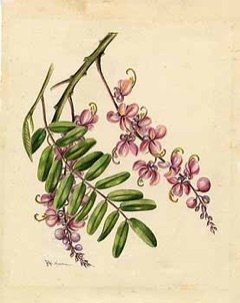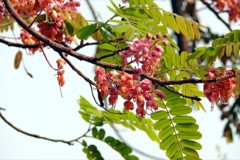 |
|
edibleplants.org |
 |
| wikimedia.org/wiki/User:Haplochromis |
Translate this page:
Summary
A spectacular flowering tree that displays masses of salmon pink flowers in clusters that open from pinkish mauve buds in spring. It is one of ther first cassia to bloom in the spring. Flowers short lived.
Physical Characteristics

 Cassia grandis is a deciduous Tree growing to 25 m (82ft) by 25 m (82ft) at a fast rate.
Cassia grandis is a deciduous Tree growing to 25 m (82ft) by 25 m (82ft) at a fast rate.
See above for USDA hardiness. It is hardy to UK zone 10. The flowers are pollinated by Insects.
It is noted for attracting wildlife.
Suitable for: light (sandy), medium (loamy) and heavy (clay) soils and prefers well-drained soil. Suitable pH: mildly acid, neutral and basic (mildly alkaline) soils. It cannot grow in the shade. It prefers moist soil.
UK Hardiness Map
US Hardiness Map
Synonyms
Bactyrilobium grande Hornem. Bactyrilobium molle Schrad. Cassia brasiliana Lam. Cassia brasiliensis Buc'hoz Cassia mollis Vahl Cassia pachycarpa de Wit Cassia regia Standl. Cathartocarpus brasilianus (Lam.) Jacq. Cathartocarpus erubescens Ham. Cathartocarpus grandis (L.f.) Pers.
Plant Habitats
Edible Uses
Edible Parts: Fruit
Edible Uses:
The pulp surrounding the seeds in the pods is edible. Sugary, but malodorous and has purgative properties if eaten in quantity[301 , 331 ].
References More on Edible Uses
Medicinal Uses
Plants For A Future can not take any responsibility for any adverse effects from the use of plants. Always seek advice from a professional before using a plant medicinally.
The bitter fruit pulp is used as a laxative and purgative similar to C. fistula and reported to be more powerful[303 , 348 , 739 ]. Drunk with milk, it is said to fight anaemia and add iron to the blood[510 ]. The ripe pods and seeds are also used as a laxative[303 ]. A decoction of the leaves is used as a laxative and in the treatment of lumbago[303 ]. The fresh juice of the leaves is used externally in the treatment of ringworm[303 ]. An ointment made from lard and the crushed leaves is employed commonly in treating cutaneous diseases, especially mange and other skin affections in dogs[331 ].
References More on Medicinal Uses
The Bookshop: Edible Plant Books
Our Latest books on Perennial Plants For Food Forests and Permaculture Gardens in paperback or digital formats.

Edible Tropical Plants
Food Forest Plants for Hotter Conditions: 250+ Plants For Tropical Food Forests & Permaculture Gardens.
More

Edible Temperate Plants
Plants for Your Food Forest: 500 Plants for Temperate Food Forests & Permaculture Gardens.
More

More Books
PFAF have eight books available in paperback and digital formats. Browse the shop for more information.
Shop Now
Other Uses
Fodder
Agroforestry Uses: A fast-growing tree it can be used as a pioneer species when re-establishing woodland[419 ]. Other Uses: The seeds are a potential commercial source of gums[303 ]. Seed gum can be used as a binder for the pharmaceutical industry[303 ]. The ashes of the wood are employed in soap-making[331 ]. The wood is brownish yellow, rather hard and heavy, coarse-textured and not durable[331 ]. A strong, multipurpose wood, it is used for building construction - mainly for internal finish, agricultural implements etc[303 , 317 , 331 , 419 ]. It is also used for fence posts[317 ]. The wood is used for fuel[303 , 331 ]. An important bee plant.
Special Uses
Carbon Farming
References More on Other Uses
Cultivation details
Agroforestry Services: Crop shade Agroforestry Services: Living fence Fodder: Pod Management: Standard Regional Crop Staple Crop: Sugar
A plant of the lowland moist tropics, found at elevations below 900 metres[303 , 331 ]. It is found in areas where the mean annual rainfall is in the range 1,000 - 2,800 mm, and the mean annual temperature is 21 - 26c with a mean maximum of 24 - 30c and a mean minimum of 17 - 25c[303 ]. Prefers a sunny position[419 ]. Succeeds in a wide range of soils[419 ]. The plant is common as an ornamental and garden escape in Malaysia, Java and New Guinea[310 ]. A fast-growing plant[419 ]. The fruit takes 10 - 12 months to mature from flowering[303 ].
Carbon Farming
-
Agroforestry Services: Crop shade
Plants providing crop shade especially trees.
-
Agroforestry Services: Living fence
Simply managed rows of shrubs and trees.
-
Fodder: Pod
Fodder plants with pods.
-
Management: Standard
Plants grow to their standard height. Harvest fruit, seeds, or other products. Non-Destructive management systems.
-
Regional Crop
These crops have been domesticated and cultivated regionally but have not been adopted elsewhere and are typically not traded globally, Examples in this broad category include perennial cottons and many nuts and staple fruits.
-
Staple Crop: Sugar
Perennial sugar crops include sugarcane and compare favorably to annuals.
References Carbon Farming Information and Carbon Sequestration Information
Temperature Converter
Type a value in the Celsius field to convert the value to Fahrenheit:
Fahrenheit:
The PFAF Bookshop
Plants For A Future have a number of books available in paperback and digital form. Book titles include Edible Plants, Edible Perennials, Edible Trees,Edible Shrubs, Woodland Gardening, and Temperate Food Forest Plants. Our new book is Food Forest Plants For Hotter Conditions (Tropical and Sub-Tropical).
Shop Now
Plant Propagation
Seed - it has a hard seedcoat and may benefit from scarification before sowing to speed up germination. This can usually be done by pouring a small amount of nearly boiling water on the seeds (being careful not to cook them!) and then soaking them for 12 - 24 hours in warm water. By this time they should have imbibed moisture and swollen - if they have not, then carefully make a nick in the seedcoat (being careful not to damage the embryo) and soak for a further 12 hours before sowing. Sow the seed in a partially shaded position in a nursery seedbed. A germination rate in excess of 60% can be expected, with the seed sprouting within 8 - 12 days[419 ]. When the seedlings are 4 - 6cm tall, pot them up into individual containers and they should be ready to plant out 5 - 6 months later[419 ]. Seed can be stored for prolonged periods without loss of viability[303 ]. Cuttings. In Costa Rica, the plant is propagated by means of large cuttings ('epicormic shoots'). Vertical shoots of 15 cm in diameter are cut and trimmed to a length of 2.5 metres. These are laid out in the shade for a week and then stacked vertically for three weeks. Then they are planted, with the lower ends buried 50 cm deep in the soil[303 ]. Layering.
Other Names
If available other names are mentioned here
Appleblossom cassia, Canafistula, Carao, Kalaa-phruek, Kotek mamak, Ngu-padamya, Nguzat-gyi, O moi, Pink shower, Sandal, Stinking toe, Trembalo-wang-wang
Native Range
NORTHERN AMERICA: Mexico (Campeche, Chiapas, Colima, Guerrero, México, Michoacán de Ocampo, Oaxaca, Quintana Roo, Tabasco, Veracruz de Ignacio de la Llave, Yucatán) SOUTHERN AMERICA: Hispaniola, Cuba (east), Jamaica, Montserrat, United States (Puerto Rico (southwest)), Central America, French Guiana, Guyana, Suriname, Venezuela, Brazil (Para, Amazonas, Mato Grosso), Colombia, Peru (Loreto (questionably native))
Weed Potential
Right plant wrong place. We are currently updating this section.
Please note that a plant may be invasive in one area but may not in your area so it's worth checking.
Conservation Status
IUCN Red List of Threatened Plants Status : This taxon has not yet been assessed

Growth: S = slow M = medium F = fast. Soil: L = light (sandy) M = medium H = heavy (clay). pH: A = acid N = neutral B = basic (alkaline). Shade: F = full shade S = semi-shade N = no shade. Moisture: D = dry M = Moist We = wet Wa = water.
Now available:
Food Forest Plants for Mediterranean Conditions
350+ Perennial Plants For Mediterranean and Drier Food Forests and Permaculture Gardens.
[Paperback and eBook]
This is the third in Plants For A Future's series of plant guides for food forests tailored to
specific climate zones. Following volumes on temperate and tropical ecosystems, this book focuses
on species suited to Mediterranean conditions—regions with hot, dry summers and cool, wet winters,
often facing the added challenge of climate change.
Read More
Expert comment
Author
L.f.
Botanical References
Links / References
For a list of references used on this page please go here
A special thanks to Ken Fern for some of the information used on this page.
Readers comment
| Add a comment |
|
If you have important information about this plant that may help other users please add a comment or link below. Only comments or links that are felt to be directly relevant to a plant will be included. If you think a comment/link or information contained on this page is inaccurate or misleading we would welcome your feedback at [email protected]. If you have questions about a plant please use the Forum on this website as we do not have the resources to answer questions ourselves.
* Please note: the comments by website users are not necessarily those held by PFAF and may give misleading or inaccurate information.
To leave a comment please Register or login here All comments need to be approved so will not appear immediately.
|
|